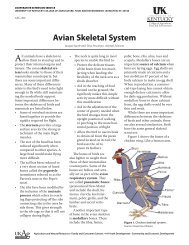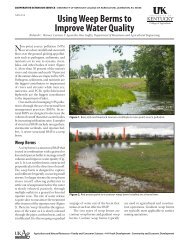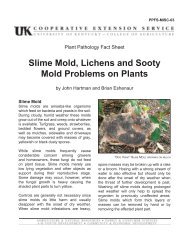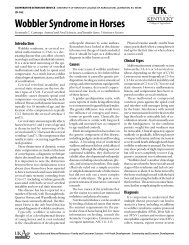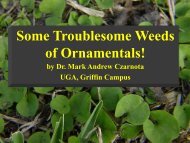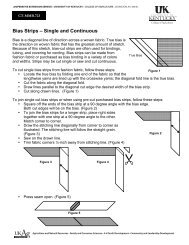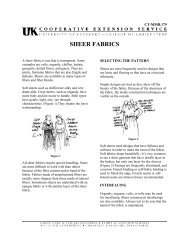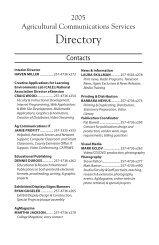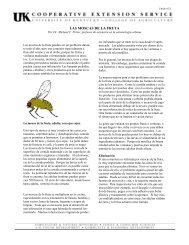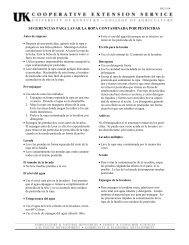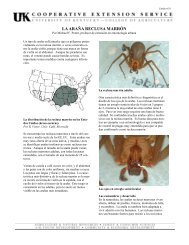Advances in equine immunology: Havemeyer workshop reports from ...
Advances in equine immunology: Havemeyer workshop reports from ...
Advances in equine immunology: Havemeyer workshop reports from ...
Create successful ePaper yourself
Turn your PDF publications into a flip-book with our unique Google optimized e-Paper software.
Short communication<br />
<strong>Advances</strong> <strong>in</strong> equ<strong>in</strong>e <strong>immunology</strong>: <strong>Havemeyer</strong> <strong>workshop</strong> <strong>reports</strong><br />
<strong>from</strong> Santa Fe, New Mexico, and Hortobagy, Hungary<br />
Abstract<br />
Eliane Marti a , David W. Horohov b , Doug F. Antzak c ,<br />
Sandor Lazary a , D. Paul Lunn d,*<br />
a<br />
Division of Cl<strong>in</strong>ical Immunology, Department of Cl<strong>in</strong>ical Veter<strong>in</strong>ary Medic<strong>in</strong>e, LaÈnggass-Strasse 124, 3012 Berne, Switzerland<br />
b<br />
Department of Pathobiological Sciences, Louisiana State University, School of Veter<strong>in</strong>ary Medic<strong>in</strong>e,<br />
Skip Bertman Dr, Baton Rouge, LA 70803, USA<br />
c<br />
Cornell University, College of Veter<strong>in</strong>ary Medic<strong>in</strong>e, Baker Institute, Ithaca, NY 14853-6401, USA<br />
d<br />
Department of Medical Sciences, School of Veter<strong>in</strong>ary Medic<strong>in</strong>e, University of Wiscons<strong>in</strong>,<br />
2015 L<strong>in</strong>den Drive, Madison, WI 53706, USA<br />
Received 17 November 2002; accepted 2 December 2002<br />
The horse has been human k<strong>in</strong>d's most important partner throughout history. Similarly, <strong>in</strong> the ®eld of <strong>immunology</strong>, many<br />
critical scienti®c advances have depended on the horse. Equ<strong>in</strong>e <strong>immunology</strong> today is an active and important ®eld of study,<br />
with a focus on control of many common <strong>in</strong>fectious diseases and immunopathologic conditions of broad comparative<br />
<strong>in</strong>terest. In 2001 two major equ<strong>in</strong>e <strong>immunology</strong> <strong>workshop</strong>s were held, <strong>in</strong> Santa Fe, USA, and <strong>in</strong> Hortobagy, Hungary, with<br />
major sponsorship <strong>from</strong> the <strong>Havemeyer</strong> Foundation. This report summarizes the scienti®c themes and foci of those<br />
meet<strong>in</strong>gs.<br />
# 2003 Elsevier Science B.V. All rights reserved.<br />
Keywords: Equ<strong>in</strong>e <strong>immunology</strong>; Infectious disease; In¯ammation; Hypersensitivity<br />
1. Introduction<br />
Veter<strong>in</strong>ary Immunology and Immunopathology 91 (2003) 233±243<br />
The horse played an important role <strong>in</strong> the early<br />
years of the modern immunological era. The diverse<br />
immunoglobul<strong>in</strong> isotypes and sub-isotypes of the<br />
horse were a common ®eld of study for immunologists<br />
<strong>in</strong>terested <strong>in</strong> immunoglobul<strong>in</strong> structure and<br />
diversity (Sandor et al., 1964; Weir et al., 1966),<br />
and equ<strong>in</strong>e anti-lymphocyte sera were commonly<br />
employed <strong>in</strong> early studies of cellular immunity<br />
*<br />
Correspond<strong>in</strong>g author. Tel.: ‡1-608-265-2671;<br />
fax: ‡1-608-265-8020.<br />
E-mail address: lunnp@svm.vetmed.wisc.edu (D. Paul Lunn).<br />
0165-2427/03/$ ± see front matter # 2003 Elsevier Science B.V. All rights reserved.<br />
doi:10.1016/S0165-2427(02)00314-8<br />
(Mosedale et al., 1968; Stewart and Bell, 1970).<br />
The advent of monoclonal antibodies removed the<br />
horse <strong>from</strong> the forefront of basic immunological<br />
<strong>in</strong>vestigation, but the horse cont<strong>in</strong>ues to contribute<br />
important comparative models of diverse immunological<br />
phenomena rang<strong>in</strong>g <strong>from</strong> comb<strong>in</strong>ed immunode®ciency<br />
(McGuire and Poppie, 1973; Sh<strong>in</strong> et al.,<br />
1997), to maternal tolerance of pregnancy (Baker<br />
et al., 1999), to immunity to lentivirus <strong>in</strong>fection<br />
(McGuire et al., 2000; Mealey et al., 2001).<br />
<strong>Advances</strong> <strong>in</strong> equ<strong>in</strong>e immunological study have<br />
depended heavily on collaborative efforts organized<br />
as <strong>workshop</strong>s, focus<strong>in</strong>g on alloantigens (Lazary et al.,<br />
1988), and more recently on characterization of
234 E. Marti et al. / Veter<strong>in</strong>ary Immunology and Immunopathology 91 (2003) 233±243<br />
leukocyte differentiation antigens and immunoglobul<strong>in</strong>s<br />
(Kydd et al., 1994; Lunn et al., 1998).<br />
In 2001 two further <strong>workshop</strong>s were held which<br />
provided a comprehensive overview of the state<br />
of equ<strong>in</strong>e immunological study with the aim of<br />
<strong>in</strong>creas<strong>in</strong>g collaborative ventures between equ<strong>in</strong>e<br />
and comparative immunological scientists. The ®rst<br />
<strong>workshop</strong>, on Equ<strong>in</strong>e Immunology, held <strong>in</strong> January,<br />
2001, <strong>in</strong> Santa Fe, New Mexico, USA, convened a<br />
group of equ<strong>in</strong>e scientists with a broad range of<br />
research <strong>in</strong>terests which all had immunological <strong>in</strong>vestigations<br />
as a central theme. The program <strong>in</strong>cluded<br />
presentations on <strong>in</strong>fectious and <strong>in</strong>¯ammatory disease,<br />
new technologies and reagent development, and an<br />
extensive proceed<strong>in</strong>gs has been published (Lunn and<br />
Wade, 2001). The second <strong>workshop</strong>, the International<br />
Symposium on Allergic Diseases of the Horse, held <strong>in</strong><br />
April 2001, <strong>in</strong> Hortobagy, Hungary, focused on<br />
immunological aspects of recurrent airway obstruction<br />
(RAO) and <strong>in</strong>sect bite hypersensitivity (IBH).<br />
Presentations also addressed genetic aspects of<br />
these diseases, new reagents and technologies useful<br />
for the study of equ<strong>in</strong>e allergic diseases and potential<br />
new therapies. Because some topics were discussed<br />
at both meet<strong>in</strong>gs, the results of these two <strong>workshop</strong>s<br />
are presented here as a s<strong>in</strong>gle report, organized by<br />
scienti®c themes.<br />
2. Infectious disease<br />
The discussion of equ<strong>in</strong>e <strong>in</strong>fectious disease<br />
<strong>in</strong>cluded a plenary presentation by Travis McGuire<br />
(Pullman, USA), provid<strong>in</strong>g a detailed overview of the<br />
immune control of equ<strong>in</strong>e <strong>in</strong>fectious anemia virus<br />
(EIAV). Recent adoptive transfer experiments to a<br />
foal suffer<strong>in</strong>g <strong>from</strong> severe comb<strong>in</strong>ed immunode®ciency<br />
us<strong>in</strong>g lymphocytes <strong>from</strong> an <strong>in</strong>fected and<br />
MHC class I matched donor have provided strong<br />
evidence for the importance of cytotoxic lymphocytes<br />
(CTLs) (Mealey et al., 2001). Limit<strong>in</strong>g dilution analysis<br />
of CTLs speci®c for EIAV Env or Gag/Pr prote<strong>in</strong>s<br />
<strong>in</strong>dicate that memory CTLs are responsible for the<br />
control of viremia (McGuire et al., 1997). In the<br />
<strong>in</strong>apparent carrier state, when viremia is under control,<br />
most horses have memory CTL that recognize Gag<br />
matrix and capsid prote<strong>in</strong>s. These CTL responses<br />
recognize a diverse set of epitopes, depend<strong>in</strong>g on<br />
the MHC-1 haplotype of the horse. In addition, antigenic<br />
variation <strong>in</strong> these epitopes is present <strong>in</strong> different<br />
EIAV stra<strong>in</strong>s. Future vacc<strong>in</strong>es will need to <strong>in</strong>duce CTL<br />
to epitopes of various prote<strong>in</strong>s <strong>in</strong> horses of different<br />
MHC-1 haplotypes (Ridgely and McGuire, 2002).<br />
Presentations on equ<strong>in</strong>e herpesvirus-1 (EHV-1), an<br />
important respiratory and abortigenic pathogen of<br />
horses which results <strong>in</strong> latent <strong>in</strong>fection, identi®ed<br />
important parallels to EIAV <strong>in</strong> terms of mechanisms<br />
of immunity. There is good evidence that CTLs play a<br />
key role <strong>in</strong> immunity (Slater, Cambridge, UK), and<br />
low levels of CTLs may predispose to <strong>in</strong>fection as<br />
documented by limit<strong>in</strong>g dilution analysis (Kydd, Newmarket,<br />
UK). Latent <strong>in</strong>fection reactivates <strong>from</strong> CD8‡<br />
lymphocytes <strong>in</strong> dra<strong>in</strong><strong>in</strong>g lymph nodes and trigem<strong>in</strong>al<br />
ganglionic neurones. Latently <strong>in</strong>fected cells do not<br />
express viral antigens, so that the immune system may<br />
only play a role <strong>in</strong> the face of reactivation. The targets<br />
of CTL responses rema<strong>in</strong> unknown, and identify<strong>in</strong>g<br />
these antigens and determ<strong>in</strong><strong>in</strong>g the role of CTLs <strong>in</strong> the<br />
respiratory epithelium lam<strong>in</strong>a propria are important<br />
goals for vacc<strong>in</strong>e development. An <strong>in</strong>vestigation of<br />
mucosal immunity to EHV-1 <strong>in</strong>fection (Breathnach,<br />
Lex<strong>in</strong>gton, USA) demonstrated a strong EHV-1 speci®c<br />
IgA response after challenge <strong>in</strong>fection, which<br />
was associated with protection <strong>from</strong> subsequent challenge<br />
(Breathnach et al., 2001).<br />
Further presentations on <strong>in</strong>fectious disease <strong>in</strong>cluded<br />
a review of immunity to Rhodococcus equi, an important<br />
<strong>in</strong>tracellular bacterial pathogen that results <strong>in</strong><br />
pyogranulomatous pneumonia <strong>in</strong> 1±6-month-old foals<br />
(Giguere, Ga<strong>in</strong>esville, USA). Virulent R. equi conta<strong>in</strong><br />
an 80±90 kbplasmid encod<strong>in</strong>g a family of seven<br />
virulence associated prote<strong>in</strong>s. Antibodies directed<br />
aga<strong>in</strong>st two of these prote<strong>in</strong>s, VapA and VapC, are<br />
at least partially protective (Hooper-McGrevy et al.,<br />
2001). The occurrence of R. equi pneumonia <strong>in</strong> foals<br />
suggests an immunologic susceptibility to disease,<br />
analogous to that seen <strong>in</strong> humans affected by human<br />
immunode®ciency virus. Investigations of cellular<br />
immunity <strong>in</strong> foals have demonstrated that animals<br />
<strong>in</strong>fected with virulent plasmid-conta<strong>in</strong><strong>in</strong>g stra<strong>in</strong>s have<br />
a reduction <strong>in</strong> IFN-gamma mRNA expression and an<br />
<strong>in</strong>creased IL-10 expression, consistent with down<br />
regulation of T-helper 1 (Th-1) responses (Giguere<br />
et al., 1999). Investigation of immunity to R. equi, and<br />
many other equ<strong>in</strong>e pathogens, has been hampered by a<br />
lack of reagents recogniz<strong>in</strong>g targets such as equ<strong>in</strong>e
cytok<strong>in</strong>es. Steve H<strong>in</strong>es (Pullman, WA) reported the<br />
development an anti-equ<strong>in</strong>e IFN-gamma monoclonal<br />
antibody that can be used for <strong>in</strong>tracellular sta<strong>in</strong><strong>in</strong>g <strong>in</strong><br />
¯ow cytometric analysis, and early results of its use <strong>in</strong><br />
the study of R. equi <strong>in</strong>fection. Flow cytometric analysis<br />
demonstrated that <strong>in</strong> adult (immune) horses,<br />
clearance of an R. equi challenge <strong>in</strong>fection was associated<br />
with an <strong>in</strong>¯ux of CD4‡/IFN-gamma‡ cells<br />
<strong>in</strong>to bronchoalveolar ¯uid. Availability of these new<br />
technologies <strong>in</strong> conjunction with new <strong>in</strong>formation<br />
about the virulence plasmid (Byrne et al., 2001) offer<br />
opportunities for ga<strong>in</strong><strong>in</strong>g a better <strong>in</strong>sight <strong>in</strong>to protective<br />
immune responses.<br />
3. Induction of mucosal immunity<br />
E. Marti et al. / Veter<strong>in</strong>ary Immunology and Immunopathology 91 (2003) 233±243 235<br />
Several presentations focused on mucosal immune<br />
responses <strong>in</strong> horses. The equ<strong>in</strong>e respiratory mucosal<br />
immune system has a key role <strong>in</strong> protection <strong>from</strong><br />
several important equ<strong>in</strong>e pathogens, and has been<br />
extensively studied (Hannant, Newmarket, UK). An<br />
<strong>in</strong>vestigation of mucosal immunity to EHV-1 <strong>in</strong>fection<br />
(Breathnach, Lex<strong>in</strong>gton, USA) demonstrated a strong<br />
EHV-1 speci®c IgA response after challenge <strong>in</strong>fection,<br />
which was associated with protection <strong>from</strong> subsequent<br />
challenge. Both <strong>in</strong>activated and modi®ed live EHV-1<br />
vacc<strong>in</strong>es failed to <strong>in</strong>duce an IgA response, or protective<br />
immunity. An extensive <strong>in</strong>vestigation of mucosal<br />
immunization strategies target<strong>in</strong>g Streptococcus equi<br />
<strong>in</strong>fection was presented by John Timoney (Lex<strong>in</strong>gton,<br />
USA). Strategies <strong>in</strong>vestigated <strong>in</strong>cluded microencapsulation<br />
of antigen, the use of a mucoadhesive compound<br />
(sucrose acetate isobutyrateÐSAIB) (Nally<br />
et al., 2000), delivery of cholera tox<strong>in</strong>/antigen chimeric<br />
molecules, and the use of avirulent Salmonella<br />
typhimurium as a mucosal vector (Sheoran et al.,<br />
2001). Both SAIB and S. typhimurium produced very<br />
promis<strong>in</strong>g results. Gisela Soboll (Madison, USA)<br />
described the use of hemagglut<strong>in</strong><strong>in</strong> (HA) gene DNA<br />
vacc<strong>in</strong>ation to protect horses <strong>from</strong> <strong>in</strong>¯uenza virus<br />
<strong>in</strong>fection. Co-adm<strong>in</strong>istration of HA DNA and cholera<br />
tox<strong>in</strong> at mucosal surfaces produced a primary mucosal<br />
IgA response and an anamnestic response after challenge<br />
<strong>in</strong>fection (Soboll et al., <strong>in</strong> press). These promis<strong>in</strong>g<br />
results suggest that practical mucosal vacc<strong>in</strong>ation<br />
strategies may be developed soon, and this will rema<strong>in</strong><br />
an important area of equ<strong>in</strong>e immunological study.<br />
4. Immune reagents<br />
Limited availability of equ<strong>in</strong>e-speci®c immunological<br />
reagents has frequently limited progress. In<br />
recent years an <strong>in</strong>creas<strong>in</strong>g list of monoclonal reagents<br />
has become available for characterization of leukocyte<br />
antigens and immunoglobul<strong>in</strong>s (Lunn et al., 1998).<br />
Many current <strong>in</strong>vestigations are focused on cytok<strong>in</strong>es,<br />
and an extensive range have been cloned (Horohov,<br />
Baton Rouge, USA). The development of various<br />
quantitative RT-PCR systems (Giguere), <strong>in</strong>clud<strong>in</strong>g<br />
real time methods (Horohov) has led to identi®cation<br />
of putative equ<strong>in</strong>e Th-1 and Th-2 responses, and<br />
application of this technique to the study of <strong>in</strong>fectious<br />
and <strong>in</strong>¯ammatory disease. Development of monoclonal<br />
antibody detection systems for equ<strong>in</strong>e cytok<strong>in</strong>es,<br />
<strong>in</strong> addition to the reagent described above for IFNgamma<br />
(H<strong>in</strong>es), rema<strong>in</strong>s a key goal.<br />
Leslie Nicolson (Glasgow, UK) described the production<br />
of biologically active recomb<strong>in</strong>ant IFN-gamma,<br />
IL-12 and IL-18, and the prelim<strong>in</strong>ary characterization of<br />
polyclonal and monoclonal antibodies to some of these<br />
cytok<strong>in</strong>es (McMonagle et al., 2001). Ste<strong>in</strong>bach (Berl<strong>in</strong>,<br />
Germany) also cloned and expressed the equ<strong>in</strong>e <strong>in</strong>terferons<br />
IFN-a, IFN-b and IFN-g and <strong>in</strong>vestigated<br />
their functional activity (Ste<strong>in</strong>bach et al., 2002). Equ<strong>in</strong>e<br />
IFN-a has a broad anti-viral activity and also <strong>in</strong>hibits<br />
proliferation of lymphocytes, while IFN-g ma<strong>in</strong>ly displayed<br />
immune modulatory effects on monocytes, upregulat<strong>in</strong>g<br />
MHC class II expression. The equ<strong>in</strong>e CC<br />
chemok<strong>in</strong>es eotax<strong>in</strong>, monocyte chemoattractant prote<strong>in</strong><br />
(MCP)-1, MCP-2 and MCP-4 have been cloned and an<br />
early <strong>in</strong>duction of equ<strong>in</strong>e eotax<strong>in</strong> and MCP-4 and upregulation<br />
of MCP-1 by recomb<strong>in</strong>ant equ<strong>in</strong>e IL-4 <strong>in</strong><br />
dermal ®broblasts have been reported (Cunn<strong>in</strong>gham,<br />
London, UK) (Benarfa et al., 2000).<br />
Flow cytometric analysis is <strong>in</strong>creas<strong>in</strong>gly widely<br />
applied to cl<strong>in</strong>ical <strong>in</strong>vestigations. These <strong>in</strong>clude evaluation<br />
of complement ®xation and opson<strong>in</strong>s (Grondahl,<br />
Uppsala, Sweden), phagocytosis and oxidative<br />
burst (Raidal, Perth, Australia; Flam<strong>in</strong>io, Ithaca,<br />
USA). The diagnosis by ¯ow cytometry of immunemediated<br />
thrombocytopenia and hemolytic anemia as<br />
well as lymphatic cancers by cell cycle analysis was<br />
also described (Rush, Manhattan, USA).<br />
A website has been established which provides<br />
<strong>in</strong>formation about equ<strong>in</strong>e speci®c reagents (http://<br />
www.vetmed.wisc.edu/research/eirh/).
236 E. Marti et al. / Veter<strong>in</strong>ary Immunology and Immunopathology 91 (2003) 233±243<br />
5. Immunogenetics<br />
An important highlight of the meet<strong>in</strong>g was an <strong>in</strong>vestigation<br />
of the equ<strong>in</strong>e immunoglobul<strong>in</strong> heavy cha<strong>in</strong><br />
gene loci, described by Bett<strong>in</strong>a Wagner (Hanover,<br />
Germany) (Wagner et al., 2002). The equ<strong>in</strong>e IgH-loci<br />
consists of one m, six g, one e, and one a genes<br />
(Overesch et al., 1998; Wagner et al., 1997, 1998).<br />
The six cg genes correspond to three of the four equ<strong>in</strong>e<br />
IgG sub-isotypes currently de®ned by monoclonal<br />
antibodies (g1 encodes IgGa, g3 encodes IgG(T),<br />
and g4 encodes IgGb), and there is serological evidence<br />
that the rema<strong>in</strong><strong>in</strong>g g genes are also expressed.<br />
Expression of IgH loci as recomb<strong>in</strong>ant complete<br />
chimeric Ig molecules <strong>in</strong> mammalian cells is now<br />
possible, and this approach has led to the production<br />
of chimeric IgE conta<strong>in</strong><strong>in</strong>g mur<strong>in</strong>e light cha<strong>in</strong>s and VH<br />
doma<strong>in</strong>s, and equ<strong>in</strong>e constant heavy cha<strong>in</strong> doma<strong>in</strong>s,<br />
which is biologically functional. This approach will<br />
considerably simplify production of monoclonal antibodies<br />
to immunoglobul<strong>in</strong>s, such as IgE, which have<br />
previously proven dif®cult to characterize <strong>in</strong> this manner.<br />
The equ<strong>in</strong>e IgE receptor alpha cha<strong>in</strong> has been<br />
cloned and expressed (McAleese, Ed<strong>in</strong>burgh, UK)<br />
(McAleese et al., 2000). These reagents will provide<br />
useful tools to further <strong>in</strong>vestigate the <strong>in</strong>volvement of<br />
IgE <strong>in</strong> hypersensitivity diseases of the horse.<br />
Additional advances <strong>in</strong> equ<strong>in</strong>e immunogenetics are<br />
result<strong>in</strong>g <strong>from</strong> the current Horse Genome Project<br />
(http://www.uky.edu/Ag/Horsemap/), <strong>in</strong>clud<strong>in</strong>g identi®cation<br />
of MHC, Ig and TCR regions (Antczak,<br />
Ithaca, USA).<br />
6. In¯ammation<br />
Endotoxaemia is manifested <strong>in</strong> a number of important<br />
and common equ<strong>in</strong>e diseases, and was comprehensively<br />
reviewed by James Moore (Athens, USA).<br />
Equ<strong>in</strong>e gastro<strong>in</strong>test<strong>in</strong>al disease frequently results <strong>in</strong><br />
absorption of endotoxic lipopolysaccharide (LPS)<br />
components of the outer membrane of enteric bacteria<br />
<strong>in</strong>to the bloodstream. The result<strong>in</strong>g endotoxaemia can<br />
be detected <strong>in</strong> the plasma of approximately 40% of<br />
horses presented to veter<strong>in</strong>ary college cl<strong>in</strong>ics with<br />
colic, and is typically associated with <strong>in</strong>test<strong>in</strong>al strangulation<br />
obstruction of severe <strong>in</strong>¯ammatory <strong>in</strong>test<strong>in</strong>al<br />
disease. In neonatal foal septicaemia, LPS is detectable<br />
<strong>in</strong> 50% of cases and is associated with derangements<br />
<strong>in</strong> hemostasis and ®br<strong>in</strong>olysis. In all these diseases<br />
survival is <strong>in</strong>versely correlated with the presence of<br />
LPS <strong>in</strong> the circulation. Under experimental conditions<br />
the onset of equ<strong>in</strong>e endotoxaemia results <strong>in</strong> peak<br />
elevations of TNF-a with<strong>in</strong> 2 h, with consequent fever<br />
and leucopenia. Many of the effects of endotoxaemia<br />
<strong>in</strong> horses are mediated by thromboxane A2, and<br />
prostagland<strong>in</strong>s E2, F2a and I2. A common sequel to<br />
endotoxaemia <strong>in</strong> horses is the development of lam<strong>in</strong>itis,<br />
a severe sterile <strong>in</strong>¯ammatory condition of the<br />
lam<strong>in</strong>ar attachments of the hoof. There is substantial<br />
evidence that local digital hemodynamic alterations<br />
play a critical role <strong>in</strong> the development of lam<strong>in</strong>itis<br />
(Moore, Baton Rouge, USA), result<strong>in</strong>g <strong>in</strong> <strong>in</strong>creased<br />
capillary pressure due to <strong>in</strong>creased venoconstriction,<br />
<strong>in</strong>creased lam<strong>in</strong>ar <strong>in</strong>terstitial pressure and oedema,<br />
thrombosis, and decreased digital blood ¯ow. Ultimately<br />
this results <strong>in</strong> lam<strong>in</strong>ar ischemia and necrosis.<br />
There is evidence that this life-threaten<strong>in</strong>g condition<br />
may result <strong>from</strong> an imbalance between endotheliumderived<br />
vasodilator (nitric oxide) and vasoconstrictor<br />
(endothel<strong>in</strong> 1; ET-1) substances. The importance of<br />
ET-1 <strong>in</strong> the aetiopathogenesis of lam<strong>in</strong>itis may <strong>in</strong>dicate<br />
the potential of ET-1 antagonists as therapeutic<br />
agents.<br />
Lameness and jo<strong>in</strong>t disease are common problems<br />
<strong>in</strong> horses lead<strong>in</strong>g to extensive suffer<strong>in</strong>g and loss of use.<br />
Wayne McIlwraith (Fort Coll<strong>in</strong>s, USA) described an<br />
extensive series of studies of the molecular basis of<br />
non-<strong>in</strong>fectious equ<strong>in</strong>e arthritis. Rheumatoid arthritis<br />
has not been described <strong>in</strong> the horse, but jo<strong>in</strong>t <strong>in</strong>¯ammation<br />
consequent to traumatic <strong>in</strong>jury is extremely<br />
common. Equ<strong>in</strong>e <strong>in</strong>¯ammatory mediators associated<br />
with the destruction of hyaluronan <strong>in</strong> synovial ¯uid<br />
and articular cartilage <strong>in</strong>clude the cytok<strong>in</strong>es IL-1 and<br />
TNF-a, several MMP's, prostagland<strong>in</strong> E 2 and free<br />
radicals. Conventional treatment has focused on<br />
symptomatic suppression of <strong>in</strong>¯ammation us<strong>in</strong>g corticosteroids<br />
or non-steroidal anti-<strong>in</strong>¯ammatory drugs.<br />
Therapy with corticosteroids is cl<strong>in</strong>ically effective, but<br />
can lead to steroid-<strong>in</strong>duced arthropathy. In vitro studies<br />
demonstrate that corticosteroids reduce type II<br />
procollagen expression by articular chondrocytes <strong>in</strong> a<br />
dose-dependent manner (MacLeod, Ithaca, USA). The<br />
therapeutic activity of conventional therapeutic<br />
agents, <strong>in</strong>clud<strong>in</strong>g corticosteroids and polysulphated<br />
glycosam<strong>in</strong>oglycans may depend on pre-translational
egulation of the iNOS gene, as nitric oxide has a role<br />
<strong>in</strong> the pathogenesis of equ<strong>in</strong>e osteoarthritis. Recently a<br />
novel gene therapy has been successfully applied <strong>in</strong> an<br />
equ<strong>in</strong>e model of jo<strong>in</strong>t arthropathy, us<strong>in</strong>g an adenoviral<br />
vector for <strong>in</strong>tra-articular delivery of the equ<strong>in</strong>e IL-1<br />
receptor antagonist (Frisbie et al., 2002; Frisbie and<br />
McIlwraith, 2000). While this result was the ®rst<br />
successful use of gene therapy for cl<strong>in</strong>ical treatment<br />
of jo<strong>in</strong>t disease, alternative gene delivery systems will<br />
be necessary for repeated treatment. Other cytok<strong>in</strong>emediated<br />
therapies are under <strong>in</strong>vestigation <strong>in</strong>clud<strong>in</strong>g<br />
the use of anabolic cytok<strong>in</strong>es such as <strong>in</strong>sul<strong>in</strong> growth<br />
factor 1.<br />
7. Hypersensitivity and airway diseases<br />
E. Marti et al. / Veter<strong>in</strong>ary Immunology and Immunopathology 91 (2003) 233±243 237<br />
Two presentations <strong>from</strong> the ®eld of human allergy<br />
<strong>in</strong>troduced the discussion of equ<strong>in</strong>e allergic diseases.<br />
CleÂmens Dah<strong>in</strong>den (Institute of Immunology and Allergology,<br />
Berne, Switzerland) highlighted the role of<br />
chemok<strong>in</strong>es, chemok<strong>in</strong>e receptors and basophils <strong>in</strong><br />
<strong>in</strong>¯ammation and allergy. Reto Crameri (SIAF, Davos,<br />
Switzerland) demonstrated a new technology allow<strong>in</strong>g<br />
the rapid clon<strong>in</strong>g of IgE-b<strong>in</strong>d<strong>in</strong>g molecules <strong>from</strong> complex<br />
allergenic sources like fungi, moulds or mites.<br />
Mould or mite extracts are complex mixtures of a large<br />
number of prote<strong>in</strong>s and glycoprote<strong>in</strong>s and the allergenic<br />
prote<strong>in</strong>s represent only a small percentage of the total<br />
prote<strong>in</strong> content. Furthermore, the composition of<br />
extracts varies between preparations, hamper<strong>in</strong>g a<br />
reproducible diagnosis as well as the study of the<br />
pathogenesis of mould-associated diseases. Pure<br />
recomb<strong>in</strong>ant (r-)allergens allow a much more sensitive<br />
and speci®c diagnosis of mould-associated diseases <strong>in</strong><br />
humans. For example, r-Aspergillus fumigatus allergens<br />
allow the discrim<strong>in</strong>ation with serological methods<br />
between IgE-mediated asthma and life-threaten<strong>in</strong>g<br />
allergic bronchopulmonary aspergillosis (Crameri,<br />
1998). Threer-A. fumigatus allergens were tested for<br />
their b<strong>in</strong>d<strong>in</strong>g of equ<strong>in</strong>e IgE <strong>in</strong> ELISA. Two of these<br />
allergens were bound signi®cantly more frequently by<br />
IgE <strong>from</strong> horses affected by RAO than <strong>from</strong> healthy<br />
control horses, suggest<strong>in</strong>g that RAO-affected horses are<br />
partly sensitized aga<strong>in</strong>st the same antigens as human<br />
patients with mould allergies (Eder et al., 2001).<br />
The horse is commonly affected by two forms of<br />
chronic airway disease: RAO <strong>in</strong> middle-aged horses;<br />
and <strong>in</strong>¯ammatory airway disease (IAD) <strong>in</strong> young<br />
performance horses (Rob<strong>in</strong>son, 2001). RAO is a<br />
severe <strong>in</strong>¯ammatory disease of middle aged and older<br />
horses <strong>in</strong>duced by exposure of susceptible horses to<br />
<strong>in</strong>haled organic dust, generally <strong>from</strong> hay, although a<br />
summer pasture-associated form (SPAOPD) is also<br />
observed <strong>in</strong> the southern United States. As moldy hay<br />
exacerbated cl<strong>in</strong>ical signs <strong>in</strong> RAO-affected horses, it<br />
was postulated that RAO is a hypersensitivity reactions<br />
to moulds such as A. fumigatus, and Faeni<br />
rectivirgula. Removal of the hay dust by return<strong>in</strong>g<br />
the horse to pasture leads to decreased <strong>in</strong>¯ammation<br />
with<strong>in</strong> a few days. In RAO-susceptible horses, exposure<br />
to hay dust leads to <strong>in</strong>vasion of the lungs and<br />
airways by neutrophils with<strong>in</strong> 4±6 h and concurrent<br />
airway obstruction due to bronchospasm, <strong>in</strong>¯ammation,<br />
and <strong>in</strong>creased mucus viscosity, which pr<strong>in</strong>cipally<br />
affect the bronchioles. RAO affected horses develop<br />
non-speci®c airway hyperresponsiveness, which is a<br />
bronchospasm <strong>in</strong> response to a wide variety of stimuli<br />
<strong>in</strong>clud<strong>in</strong>g <strong>in</strong>¯ammatory mediators and neurotransmitters.<br />
The importance of <strong>in</strong>¯ammation <strong>in</strong> RAO is<br />
demonstrated by the responsiveness of the condition<br />
to corticosteroid therapy (Rob<strong>in</strong>son, East Lans<strong>in</strong>g, MI,<br />
USA).<br />
IAD affects approximately 30% of young horses <strong>in</strong><br />
tra<strong>in</strong><strong>in</strong>g. This condition has been associated with<br />
bacterial and viral <strong>in</strong>fections, but <strong>in</strong> many horses no<br />
<strong>in</strong>fectious aetiology is identi®ed and allergic and<br />
environmental factors are implicated. The condition<br />
is typically associated with neutrophilic airway<br />
<strong>in</strong>¯ammation, although <strong>in</strong> some cases eos<strong>in</strong>ophils or<br />
mast cell numbers are <strong>in</strong>creased. Younger horses<br />
affected by IAD show high sensitivity to low levels<br />
of <strong>in</strong>haled aerosols conta<strong>in</strong><strong>in</strong>g histam<strong>in</strong>e <strong>in</strong> comparison<br />
to older RAO-affected animals (Viel, Guelph,<br />
Canada). There is presently no evidence that IAD can<br />
develop <strong>in</strong>to RAO or whether these conditions are<br />
completely separate cl<strong>in</strong>ical entities. There is no way<br />
to predict <strong>in</strong> early life which horses will be affected by<br />
either condition. Horses affected by chronic non<strong>in</strong>fectious<br />
airway diseases, such as RAO and IAD,<br />
demonstrate <strong>in</strong>creased histological lesions and worsen<strong>in</strong>g<br />
airway function with <strong>in</strong>creas<strong>in</strong>g age. In addition,<br />
signi®cant histopathological changes are present<br />
before abnormal airway function can be detected. It is<br />
questionable whether mild airway <strong>in</strong>¯ammation <strong>in</strong><br />
stabled horses is cl<strong>in</strong>ically signi®cant, or is a normal
238 E. Marti et al. / Veter<strong>in</strong>ary Immunology and Immunopathology 91 (2003) 233±243<br />
response to organic dust found <strong>in</strong> stable environments.<br />
It does not seem to impair dressage or show-jump<strong>in</strong>g<br />
performance (Gerber, East Lans<strong>in</strong>g, MI, USA). However,<br />
assessment of lung function (Hoffman, North<br />
Grafton, USA; Ohnesorge, Hanover, Germany) discrim<strong>in</strong>ates<br />
between healthy and IAD horses, suggest<strong>in</strong>g<br />
that this mild <strong>in</strong>¯ammation can cause dysfunction<br />
of the lung.<br />
There is evidence that the neutrophilic <strong>in</strong>¯ammation<br />
that is characteristic of chronic airway disease <strong>in</strong><br />
horses is <strong>in</strong>duced by IL-8 production, and IL-8 levels<br />
<strong>in</strong> BAL ¯uid are <strong>in</strong>creased <strong>in</strong> RAO-affected horses<br />
(Franch<strong>in</strong>i, ZuÈrich, Switzerland) (Franch<strong>in</strong>i et al.,<br />
2000). There is also a strong correlation between<br />
levels of airway MMP-9 and airway neutrophilia<br />
(Maisi, Hels<strong>in</strong>ki, F<strong>in</strong>land) (Nevala<strong>in</strong>en et al., 2002)<br />
consistent with the importance of MMP-9 <strong>in</strong> neutrophil<br />
transmigration through the airway basement<br />
membrane (McGorum, Ed<strong>in</strong>burgh, Scotland). When<br />
RAO susceptible horses are antigen challenged, peripheral<br />
blood and airway neutrophils are primed, as<br />
demonstrated by <strong>in</strong>creased superoxide production and<br />
respiratory burst activity (Brazil, Ed<strong>in</strong>burgh, Scotland).<br />
Neutrophil degranulation products are <strong>in</strong>creased<br />
<strong>in</strong> airways, <strong>in</strong>clud<strong>in</strong>g neutrophil elastase and MMP-9.<br />
Much of the neutrophil elastase <strong>in</strong> <strong>in</strong>active, while<br />
much of the MMP-9 is active (Raulo et al., 2001).<br />
However, <strong>in</strong> contrast to human chronic obstructive<br />
airway disease, airway remodel<strong>in</strong>g <strong>in</strong> RAO-affected<br />
horses is m<strong>in</strong>imal. This may be due to <strong>in</strong>creased<br />
ef®cacy of the equ<strong>in</strong>e antiprote<strong>in</strong>ase system. For<br />
example, equ<strong>in</strong>e alpha-1-prote<strong>in</strong>ase <strong>in</strong>hibitor (API)<br />
is encoded by multiple alleles, <strong>in</strong> contrast to the s<strong>in</strong>gle<br />
human locus, and BAL ¯uid levels are much higher <strong>in</strong><br />
horses than <strong>in</strong> humans, <strong>in</strong> both health and disease. In<br />
addition, equ<strong>in</strong>e API is not a neutrophil chemoattractant.<br />
Dur<strong>in</strong>g the resolution of RAO, apoptosis of airway<br />
neutrophils is <strong>in</strong>creased, and consequently<br />
neutrophil function and the result<strong>in</strong>g tissue damage<br />
are reduced (Brazil, Ed<strong>in</strong>burgh, Scotland). In contrast,<br />
dur<strong>in</strong>g exacerbations of RAO, neutrophil apoptosis is<br />
reduced possibly through cytok<strong>in</strong>e mediated upregulation<br />
of NF-kB. NF-kB is highly activated <strong>in</strong> bronchial<br />
brush<strong>in</strong>g samples (BBS) and BAL cells <strong>from</strong><br />
RAO-affected horses compared with healthy horses<br />
and is highly correlated to the degree of residual lung<br />
dysfunction 3 weeks after antigen eviction (Bureau<br />
et al., 2000). Active NF-kB complexes <strong>in</strong> BBS and<br />
BAL cells <strong>from</strong> RAO-affected horses are ma<strong>in</strong>ly p65<br />
heterodimers. This ®nd<strong>in</strong>g could offer an explanation<br />
for why RAO-associated <strong>in</strong>¯ammation is neutrophilic<br />
and eos<strong>in</strong>ophil numbers are usually not elevated <strong>in</strong><br />
BAL <strong>from</strong> RAO-affected horses. Expression of p65<br />
homodimers <strong>in</strong>duces IL-8, a potent neutrophilic chemoattractant,<br />
but not other chemoattractants such as<br />
eotax<strong>in</strong>, an eos<strong>in</strong>ophilic chemoattractant which is<br />
under p65±p50 control (Lekeux, LieÁge, Belgium).<br />
Recent studies suggest that the presence of highly<br />
activated NF-kB <strong>in</strong> BBS and BAL cells <strong>from</strong> RAOaffected<br />
horses may be due to failure of deactivation of<br />
byIkB-b. This is due to an imbalance between high<br />
levels of IL-1b and TNF-a mediated IkB-b degradation<br />
and low levels of IkB-b synthesis.<br />
Bronchospasm <strong>in</strong> horses with RAO results <strong>from</strong><br />
facilitation of parasympathetically mediated smooth<br />
muscle contraction by <strong>in</strong>¯ammatory mediators. In<br />
vitro studies have shown that activated neutrophils<br />
do not affect chol<strong>in</strong>ergic responses <strong>in</strong> equ<strong>in</strong>e airways,<br />
but mediators <strong>from</strong> mast cell, such as histam<strong>in</strong>e,<br />
seroton<strong>in</strong>, and leucotriene D4 greatly facilitate smooth<br />
muscle contraction and could be responsible for the<br />
chol<strong>in</strong>ergic mediated bronchospasm <strong>in</strong> RAO (Olszewski,<br />
East Lans<strong>in</strong>g, MI, USA) (Olszewski et al.,<br />
1999).<br />
Inhalation challenges with endotox<strong>in</strong> (Pirie et al.,<br />
2001), or a hay dust suspension (Pirie et al., 2002),<br />
have revealed that airborne endotox<strong>in</strong>s present <strong>in</strong><br />
relatively high concentrations <strong>in</strong> dusty stable environment<br />
(McGorum et al., 1998), contribute to pulmonary<br />
<strong>in</strong>¯ammation and dysfunction <strong>in</strong> RAO. However,<br />
other components of the hay dust suspension, especially<br />
particulates, are required to <strong>in</strong>duce lung <strong>in</strong>¯ammation<br />
and dysfunction <strong>in</strong> RAO-susceptible horses<br />
comparable to that of the natural disease (Pirie, Ed<strong>in</strong>burgh,<br />
UK). Interest<strong>in</strong>gly, <strong>in</strong>haled endotox<strong>in</strong>s have<br />
been shown to be <strong>in</strong>volved <strong>in</strong> human organic dust<br />
<strong>in</strong>duced pulmonary disease and RAO shares some<br />
features with this human lung disease.<br />
The immunological basis of RAO rema<strong>in</strong>s poorly<br />
elucidated. While IgE levels are <strong>in</strong>creased <strong>in</strong> bronchoalveolar<br />
(BAL) ¯uid of RAO-affected horses, consistent<br />
with a type-1 hypersensitivity, the immediate<br />
onset of airway obstruction typical of a type-1 reaction<br />
to exposure to allergens is not observed. In addition,<br />
<strong>in</strong>tradermal tests with various allergen extracts correlate<br />
poorly with the cl<strong>in</strong>ical diagnosis (Jose-Cunilleras
et al., 2001). GruÈnig (New York, NY) reviewed the<br />
role of T cell subsets and of Th1, Th2 and immune<br />
regulatory cytok<strong>in</strong>es <strong>in</strong> human chronic <strong>in</strong>¯ammatory<br />
lung disease and <strong>in</strong> a mouse model of asthma.<br />
Although a polarization of T helper cells <strong>in</strong>to predom<strong>in</strong>antly<br />
Th1 and Th2 subsets has not been conclusively<br />
documented <strong>in</strong> the horse, studies suggest that<br />
equ<strong>in</strong>e Th1 and Th2-like immune responses do occur.<br />
Results of <strong>in</strong>itial studies on the type of immune<br />
response associated with RAO have been <strong>in</strong>consistent.<br />
Us<strong>in</strong>g <strong>in</strong> situ hybridization, BAL cells <strong>from</strong> horses<br />
with RAO chronically exposed to dusty hay had<br />
<strong>in</strong>creased expression of IL-4 and IL-5 mRNA and<br />
decreased IFN-g mRNA expression compared to controls<br />
(Lavoie et al., 2001). However, <strong>in</strong> other prelim<strong>in</strong>ary<br />
studies us<strong>in</strong>g RT-PCR on BAL cells no<br />
consistent ®nd<strong>in</strong>gs relat<strong>in</strong>g to cytok<strong>in</strong>e mRNA expression<br />
<strong>in</strong> RAO-affected animals could be found (Lavoie,<br />
MontreÂal, Canada). A quantitative RT-PCR analysis of<br />
horses affected with SPAOPD demonstrated elevated<br />
levels of mRNA for IL-4 and IL-13 dur<strong>in</strong>g the summer,<br />
while control animals exhibited a bias towards<br />
IFN-g mRNA production (Horohov, Baton Rouge,<br />
LA) (Beadle et al., 2002). A full understand<strong>in</strong>g of<br />
the immunological basis of equ<strong>in</strong>e chronic airway<br />
diseases will require improved immunological tools,<br />
such as antibody detection systems for cytok<strong>in</strong>es and<br />
IgE, and the development of equ<strong>in</strong>e models for these<br />
conditions (Bowles et al., 2002).<br />
8. Insect bite hypersensitivity<br />
E. Marti et al. / Veter<strong>in</strong>ary Immunology and Immunopathology 91 (2003) 233±243 239<br />
Equ<strong>in</strong>e IBH, also known as sweet-itch or summer<br />
eczema, is a recurrent, seasonal pruritic dermatitis of<br />
the horse (Marti, Berne, Switzerland). As shown by<br />
sk<strong>in</strong> tests, IBH results <strong>from</strong> hypersensitivity reactions<br />
to <strong>in</strong>sect bites, ma<strong>in</strong>ly <strong>from</strong> midges (Culicoides spp.)<br />
and sometimes <strong>from</strong> black ¯ies (Simulium spp.). IBH<br />
occurs worldwide <strong>in</strong> areas where these <strong>in</strong>sects occur<br />
with a prevalence of 3±5%, although this can be much<br />
higher <strong>in</strong> some horse families and particularly <strong>in</strong><br />
Icelandic horses imported <strong>from</strong> Iceland (where these<br />
<strong>in</strong>sects do not occur) to Europe or North America (see<br />
below). Horses with IBH suffer <strong>from</strong> severe pruritic<br />
dermatosis affect<strong>in</strong>g the mane and the tail area and<br />
sometimes also the ventral midl<strong>in</strong>e. Histopathology of<br />
lesional sk<strong>in</strong> biopsies reveals a perivascular dermatitis<br />
with eos<strong>in</strong>ophilic and lymphocytic <strong>in</strong>®ltrates. In<br />
chronic lesions, there is usually a perivascular lymphocytic<br />
<strong>in</strong>®ltration with or without a small number of<br />
eos<strong>in</strong>ophils. Currently, treatment of IBH depends on<br />
avoidance of contact with <strong>in</strong>sects and the use of<br />
corticosteroids. The ef®cacy of speci®c immunotherapy<br />
with Culicoides whole body extracts is controversial<br />
and is only rarely attempted.<br />
Intradermal <strong>in</strong>jection of Culicoides extract (Cunn<strong>in</strong>gham,<br />
London, UK) leads to a time-dependent<br />
accumulation of eos<strong>in</strong>ophils and mononuclear cells<br />
<strong>in</strong> the sk<strong>in</strong> of <strong>in</strong> sweet-itch affected horses, consist<strong>in</strong>g<br />
of CD3-positive (‡) lymphocytes, most of which are<br />
CD4‡ T cells (McKelvie et al., 1999). Culicoides<br />
antigen(s) causes a concentration-dependent proliferation<br />
of PBMCs which is higher <strong>in</strong> sweet-itch ponies<br />
than <strong>in</strong> controls dur<strong>in</strong>g the active phase of the disease.<br />
Additionally, PBMC stimulated with Culicoides<br />
extract release a heat labile factor that causes eos<strong>in</strong>ophil<br />
adherence (McKelvie et al., 2001). Equ<strong>in</strong>e<br />
eotax<strong>in</strong> mRNA has been detected <strong>in</strong> the cl<strong>in</strong>ically<br />
normal sk<strong>in</strong> of ponies with IBH but not <strong>in</strong> the sk<strong>in</strong><br />
of unaffected animals. The amount of eotax<strong>in</strong> mRNA<br />
<strong>in</strong> lesional sk<strong>in</strong> was <strong>in</strong>creased compared to that <strong>in</strong><br />
normal sk<strong>in</strong>, suggest<strong>in</strong>g that this chemok<strong>in</strong>e may play<br />
a part <strong>in</strong> Culicoides-<strong>in</strong>duced eos<strong>in</strong>ophil recruitment to<br />
the sk<strong>in</strong> of sweet-itch ponies.<br />
A series of presentations demonstrated that IgEmediated<br />
immune reactions are probably <strong>in</strong>volved <strong>in</strong><br />
the pathogenesis of IBH. Lesional sk<strong>in</strong> biopsies <strong>from</strong><br />
horses with IBH conta<strong>in</strong> signi®cantly more IgE, IgEmRNA<br />
positive cells and tryptase positive mast cells<br />
than sk<strong>in</strong> biopsies <strong>from</strong> healthy control horses (van der<br />
Haegen et al., 2001). Two presentations described the<br />
release of mediators (histam<strong>in</strong>e and sul®doleukotrienes)<br />
<strong>from</strong> peripheral blood leukocytes after <strong>in</strong> vitro<br />
stimulation with allergen extracts or antibodies. Leukocytes<br />
<strong>from</strong> horses with IBH release signi®cantly<br />
more sul®doleukotrienes (Marti, Berne, Switzerland)<br />
or histam<strong>in</strong>e (Leibold, Hanover, Germany) when <strong>in</strong>cubated<br />
with a Culicoides extract than leukocytes <strong>from</strong><br />
healthy controls, and there is a strong positive correlation<br />
between histam<strong>in</strong>e and sLT release (Marti et al.,<br />
1999). Simulids also <strong>in</strong>duce signi®cant histam<strong>in</strong>e and<br />
sul®doleukotrienes release <strong>in</strong> some horses affected<br />
with IBH. Leibold also showed that histam<strong>in</strong>e release<br />
can be <strong>in</strong>duced <strong>in</strong> some foals with a polyclonal anti-<br />
IgG heavy ‡ light cha<strong>in</strong> or with Culicoides extract,
240 E. Marti et al. / Veter<strong>in</strong>ary Immunology and Immunopathology 91 (2003) 233±243<br />
although these foals had no cl<strong>in</strong>ical signs of IBH.<br />
These ®nd<strong>in</strong>gs suggest that sensitization can occur<br />
early <strong>in</strong> life <strong>in</strong> the horse.<br />
The presence of antibodies <strong>in</strong> horse sera b<strong>in</strong>d<strong>in</strong>g to<br />
Culicoides salivary glands was demonstrated by<br />
immunohistological sta<strong>in</strong><strong>in</strong>g (Harwood, Bristol,<br />
UK). IgE antibodies could only be detected <strong>in</strong> sera<br />
<strong>from</strong> horses with cl<strong>in</strong>ical signs of IBH, but not <strong>in</strong> sera<br />
<strong>from</strong> healthy controls or <strong>in</strong> sera <strong>from</strong> horses with a<br />
history of IBH but <strong>in</strong> remission at the time of sampl<strong>in</strong>g.<br />
Anti-salivary gland IgG antibodies were<br />
detected <strong>in</strong> sera <strong>from</strong> both IBH-affected and healthy<br />
horses exposed to Culicoides spp, but not <strong>in</strong> sera <strong>from</strong><br />
unexposed horses (Wilson et al., 2001).<br />
The saliva of hematophagous <strong>in</strong>sects conta<strong>in</strong>s a<br />
diverse range of factors that assist <strong>in</strong> successful<br />
blood-feed<strong>in</strong>g. Few salivary glands prote<strong>in</strong>s <strong>from</strong><br />
Culicoides have been identi®ed (Perez de Leon and<br />
Tabachnick, 1996), and their role as potential allergen<br />
is unknown. Presently only crude full body extracts<br />
<strong>from</strong> Culicoides spp. and Simulium spp. are available<br />
commercially. These crude extracts, where the allergens<br />
only represent a m<strong>in</strong>ute amount of the total<br />
extract, hamper studies of the pathogenesis of IBH<br />
as well as ef®cient-speci®c immunotherapy. One solution<br />
could be the production of recomb<strong>in</strong>ant Culicoides<br />
allergens. This work has started with the<br />
construction of a Culicoides cDNA library which<br />
will be screened with sera <strong>from</strong> IBH affected horses<br />
(Harwood, Bristol, UK).<br />
IBH does not occur <strong>in</strong> horses born and liv<strong>in</strong>g <strong>in</strong><br />
Iceland because Culicoides spp. are not present there.<br />
However, when Icelandic horses are imported <strong>from</strong><br />
Iceland to Europe (where Culicoides spp. are present)<br />
50% of adults suffer <strong>from</strong> IBH if more than 2 years<br />
have passed s<strong>in</strong>ce importation (Svansson, Reykjavik,<br />
Iceland). Onset of the disease takes place between 1<br />
and 8 years after importation <strong>from</strong> Iceland, with a<br />
mean of 2.4 years. In contrast, only 7±10% of the<br />
Icelandic horses born <strong>in</strong> Europe suffer <strong>from</strong> IBH<br />
(Brostrom et al., 1987; Halldorsdottir and Larsen,<br />
1991). The reasons for this phenomenon are unknown.<br />
Studies are underway to <strong>in</strong>vestigate whether genetic<br />
factors (i.e. lack of selection aga<strong>in</strong>st IBH <strong>in</strong> Iceland)<br />
contribute to the high prevalence of IBH <strong>in</strong> horses<br />
imported <strong>from</strong> Iceland to Culicoides populated areas.<br />
The therapeutic potential of DNA vacc<strong>in</strong>ation <strong>in</strong><br />
equ<strong>in</strong>e hypersensitivity was summarized by Lunn<br />
(Madison, WI, USA). There is evidence that TH2type<br />
immune responses may contribute to allergic<br />
disease <strong>in</strong> the horse. Switch<strong>in</strong>g this immunological<br />
response to a TH1 phenotype is the base of immunotherapy<br />
for allergic diseases (Janeway et al., 2002).<br />
DNA vacc<strong>in</strong>ation offers an attractive technique for<br />
attempt<strong>in</strong>g this form of therapy, as DNA vacc<strong>in</strong>ation<br />
typically results <strong>in</strong> a TH1 immune response. In the<br />
horse successful DNA vacc<strong>in</strong>ation aga<strong>in</strong>st <strong>in</strong>fectious<br />
diseases has been performed us<strong>in</strong>g the gene gun (Lunn<br />
et al., 1999). To test the potential of DNA immunization<br />
as a therapy aga<strong>in</strong>st allergic diseases of the horse,<br />
a model compar<strong>in</strong>g the equ<strong>in</strong>e immune response after<br />
immunization with human serum album<strong>in</strong> prote<strong>in</strong><br />
(HSA) and plasmid HSA-DNA is be<strong>in</strong>g established<br />
(Torste<strong>in</strong>sdottir, Reykjavik, Iceland).<br />
9. Hypersensitivity and immunogenetics<br />
The genetic basis of human allergic diseases has<br />
been demonstrated <strong>in</strong> numerous studies and polymorphisms<br />
<strong>in</strong> several candidate genes show association<br />
with allergic conditions <strong>in</strong> humans (Barnes and<br />
Marsh, 1998). Matthew B<strong>in</strong>ns (Newmarket, UK)<br />
expla<strong>in</strong>ed how comparative genetics, through test<strong>in</strong>g<br />
of candidate genes identi®ed <strong>in</strong> human allergy, may<br />
allow identi®cation of genetic markers for equ<strong>in</strong>e<br />
allergic diseases. The horse genome map (http://locus.jouy.<strong>in</strong>ra.fr;<br />
http://www.uky.edu/ag/horsemap) has<br />
now reached the stage where it can start be<strong>in</strong>g used<br />
for ®nd<strong>in</strong>g genetic markers for different traits <strong>in</strong> the<br />
horse and <strong>in</strong> particular also for IBH and RAO. A<br />
genetic basis for these two conditions has previously<br />
been established (Marti et al., 1991, 1992). Curik<br />
(Zagreb, Croatia) showed that speci®c serum IgE<br />
levels <strong>in</strong> the horse are <strong>in</strong>¯uenced by genetic factors<br />
although, as can be expected, the environment also<br />
exerts a signi®cant effect (Eder et al., 2001). Curik also<br />
demonstrated that the ability to produce IgE aga<strong>in</strong>st<br />
some pure recomb<strong>in</strong>ant mould allergens may be <strong>in</strong>¯uenced<br />
by the equ<strong>in</strong>e MHC. Signi®cant associations<br />
between equ<strong>in</strong>e leukocyte antigens or markers closely<br />
l<strong>in</strong>ked to the MHC and IgE levels aga<strong>in</strong>st recomb<strong>in</strong>ant<br />
A. fumigatus allergens were found <strong>in</strong> Lipizzaner<br />
horses. The search for the other genes <strong>in</strong>¯uenc<strong>in</strong>g<br />
IgE levels will be a ®rst step towards identify<strong>in</strong>g<br />
genetic markers for allergic diseases <strong>in</strong> the horse.
10. Conclusions<br />
Equ<strong>in</strong>e immunological research rema<strong>in</strong>s at the scienti®c<br />
forefront of veter<strong>in</strong>ary medic<strong>in</strong>e, and the small but<br />
active community of equ<strong>in</strong>e immunologists have been<br />
quick to adopt the latest techniques to advance their<br />
work. Nevertheless, the pr<strong>in</strong>cipal limitations <strong>in</strong> this<br />
®eld rema<strong>in</strong> the lack of key reagents, such as for the<br />
study of cytok<strong>in</strong>es, the characterization of MHC and<br />
TCR diversity, and the identi®cation of antigen-speci®c<br />
immune responses. To realize our goals of controll<strong>in</strong>g<br />
<strong>in</strong>fectious and allergic disease <strong>in</strong> the horse it will be<br />
essential to address these challenges. The rewards of<br />
these efforts will bene®t not only the horse, but can<br />
provide unique opportunities for comparative immunological<br />
studies of disease.<br />
Acknowledgements<br />
Pr<strong>in</strong>cipal sponsorship for both these meet<strong>in</strong>gs was<br />
provided by the <strong>Havemeyer</strong> Foundation. Additional<br />
support for the Santa Fe meet<strong>in</strong>g was provided by<br />
Heska Inc., Bayer, Intervet Inc., and the Veter<strong>in</strong>ary<br />
Immunology Committee of the International Union of<br />
Immunological Societies.<br />
References<br />
E. Marti et al. / Veter<strong>in</strong>ary Immunology and Immunopathology 91 (2003) 233±243 241<br />
Baker, J.M., Bamford, A.I., Antczak, D.F., 1999. Modulation of<br />
allospeci®c CTL responses dur<strong>in</strong>g pregnancy <strong>in</strong> equids: an<br />
immunological barrier to <strong>in</strong>terspecies mat<strong>in</strong>gs? J. Immunol.<br />
162, 4496±4501.<br />
Barnes, K.C., Marsh, D.G., 1998. The genetics and complexity of<br />
allergy and asthma. Immunol. Today 19, 325±332.<br />
Beadle, R.E., Horohov, D.W., Gaunt, S.D., 2002. Interleuk<strong>in</strong>-4 and<br />
<strong>in</strong>terfeon-gamma gene expression <strong>in</strong> summer pasture-associated<br />
obstructive pulmonary disease affected horses. Equ<strong>in</strong>e<br />
Vet. J. 34, 389±394.<br />
Benarfa, C., Cunn<strong>in</strong>gham, F.M., Hambl<strong>in</strong>, A., Horohov, D.W.,<br />
Coll<strong>in</strong>s, M.E., 2000. Clon<strong>in</strong>g of equ<strong>in</strong>e chemok<strong>in</strong>es eotax<strong>in</strong>,<br />
monocyte chemoattractant prote<strong>in</strong> (MCP)-1, MCP-2 and MCP-<br />
4, mRNA expression <strong>in</strong> tissues and <strong>in</strong>duction by IL-4 <strong>in</strong> dermal<br />
®broblasts. Vet. Immunol. Immunopathol. 76, 283±298.<br />
Bowles, K.S., Beadle, R.E., Mouch, S., Pourciau, S.S., Little®eld-<br />
Chabaud, M.A., Le Blanc, C., Mistric, L., Fermaglich, D.,<br />
Horohov, D.W., 2002. A novel model for equ<strong>in</strong>e recurrent<br />
airway obstruction. Vet. Immunol. Immunopathol. 87, 385±389.<br />
Breathnach, C.C., Yeargan, M.R., Sheoran, A.S., Allen, G., 2001.<br />
The mucosal humoral immune response of the horse to<br />
<strong>in</strong>fective challenge and vacc<strong>in</strong>ation with equ<strong>in</strong>e herpesvirus-1<br />
antigen. Equ<strong>in</strong>e Vet. J. 33, 651.<br />
Brostrom, H., Larsson, A., Troedsson, M., 1987. Allergic<br />
dermatitis (sweet itch) of Icelandic horses <strong>in</strong> Sweden: an<br />
epidemiological study. Equ<strong>in</strong>e Vet. J. 19, 229±236.<br />
Bureau, F., Bonizzi, G., Kirschv<strong>in</strong>k, N., Delhalle, S., Desmecht, D.,<br />
Merville, M.P., Bours, V., Lekeux, P., 2000. Correlation<br />
between nuclear factor-kappaB activity <strong>in</strong> bronchial brush<strong>in</strong>g<br />
samples and lung dysfunction <strong>in</strong> an animal model of asthma.<br />
Am. J. Resp. Crit. Care Med. 161, 1314±1321.<br />
Byrne, B.A., Prescott, J.F., Palmer, G.H., Takai, S., Nicholson,<br />
V.M., Alper<strong>in</strong>, D.C., H<strong>in</strong>es, S.A., 2001. Virulence plasmid of<br />
Rhodococcus equi conta<strong>in</strong>s <strong>in</strong>ducible gene family encod<strong>in</strong>g<br />
secreted prote<strong>in</strong>s. Infect. Immunity 69, 650±656.<br />
Crameri, R., 1998. Recomb<strong>in</strong>ant Aspergillus fumigatus allergens:<br />
<strong>from</strong> the nucleotide sequences to cl<strong>in</strong>ical applications. Int.<br />
Archiv. Allergy Immunol. 115, 99±114.<br />
Eder, C., Curik, I., Brem, G., Crameri, R., Bodo, I., Habe, F.,<br />
Lazary, S., Solkner, J., Marti, E., 2001. In¯uence of environmental<br />
and genetic factors on allergen-speci®c immunoglobul<strong>in</strong>-E<br />
levels <strong>in</strong> sera <strong>from</strong> Lipizzan horses. Equ<strong>in</strong>e Vet. J. 33,<br />
714±720.<br />
Franch<strong>in</strong>i, M., Gill, U., von Fellenberg, R., Bracher, V.D., 2000.<br />
Interleuk<strong>in</strong>-8 concentration and neutrophil chemotactic activity<br />
<strong>in</strong> bronchoalveolar lavage ¯uid of horses with chronic<br />
obstructive pulmonary disease follow<strong>in</strong>g exposure to hay.<br />
Am. J. Vet. Res. 61, 1369±1374.<br />
Frisbie, D.D., McIlwraith, C.W., 2000. Evaluation of gene therapy<br />
as a treatment for equ<strong>in</strong>e traumatic arthritis and osteoarthritis.<br />
Cl<strong>in</strong>. Orthop. Relat. Res. (379 suppl.), S273±S287.<br />
Frisbie, D.D., Ghivizzani, S.C., Robb<strong>in</strong>s, P.D., Evans, C.H.,<br />
McIlwraith, C.W., 2002. Treatment of experimental equ<strong>in</strong>e<br />
osteoarthritis by <strong>in</strong> vivo delivery of the equ<strong>in</strong>e <strong>in</strong>terleuk<strong>in</strong>-1<br />
receptor antagonist gene. Gene Therapy 9, 12±20.<br />
Giguere, S., Wilkie, B.N., Prescott, J.F., 1999. Modulation of<br />
cytok<strong>in</strong>e response of pneumonic foals by virulent Rhodococcus<br />
equi. Infect. Immunity 67, 5041±5047.<br />
Halldorsdottir, S., Larsen, H.J., 1991. An epidemiological study of<br />
summer eczema <strong>in</strong> Icelandic horses <strong>in</strong> Norway. Equ<strong>in</strong>e Vet. J.<br />
23, 296±299.<br />
Hooper-McGrevy, K.E., Giguere, S., Wilkie, B.N., Prescott, J.F.,<br />
2001. Evaluation of equ<strong>in</strong>e immunoglobul<strong>in</strong> speci®c for<br />
Rhodococcus equi virulence-associated prote<strong>in</strong>s A and C for<br />
use <strong>in</strong> protect<strong>in</strong>g foals aga<strong>in</strong>st Rhodococcus equi-<strong>in</strong>duced<br />
pneumonia. Am. J. Vet. Res. 62, 1307±1313.<br />
Janeway Jr., C.A., Travers, P., Walport, M., Shlomchik, M., 2002.<br />
Allergy and hypersensitivity. In: Immunobiology. Garland<br />
Publish<strong>in</strong>g, New York, pp. 471±500.<br />
Jose-Cunilleras, E., Kohn, C.W., Hillier, A., Saville, W.J., Lorch,<br />
G., 2001. Intradermal test<strong>in</strong>g <strong>in</strong> healthy horses and horses<br />
with chronic obstructive pulmonary disease, recurrent urticaria,<br />
or allergic dermatitis. J. Am. Vet. Med. Assoc. 219, 1115±<br />
1121.<br />
Kydd, J.H., Antczak, D.F., Allen, W.R., Barbis, D., Butcher, G.,<br />
Davis, W., Duffus, W.P.H., Ed<strong>in</strong>gton, N., Grunig, G., Holmes,<br />
M.A., Lunn, D.P., McCullock, J., O'Brien, M.A., Perryman,<br />
L.E., Tavernor, A.S., Williamson, S., Zhang, C., 1994. Report
242 E. Marti et al. / Veter<strong>in</strong>ary Immunology and Immunopathology 91 (2003) 233±243<br />
of the First International Workshop on Equ<strong>in</strong>e Leucocyte<br />
Antigens, Cambridge, UK, July 1991. Vet. Immunol. Immunopathol.<br />
42, 1±60.<br />
Lavoie, J.P., Maghni, K., Desnoyers, M., Taha, R., Mart<strong>in</strong>, J.G.,<br />
Hamid, Q.A., 2001. Neutrophilic airway <strong>in</strong>¯ammation <strong>in</strong> horses<br />
with heaves is characterized by a Th2-type cytok<strong>in</strong>e pro®le.<br />
Am. J. Resp. Crit. Care Med. 164, 1410±1413.<br />
Lazary, S., Antczak, D.F., Bailey, E., Bell, T.K., Bernoco, D.,<br />
Byrns, G., McClure, J.J., 1988. Jo<strong>in</strong>t Report of the Fifth<br />
International Workshop on Lymphocyte Alloantigens of the<br />
Horse, Baton Rouge, Louisiana, October 31±November 1,<br />
1987. Anim. Genet. 19, 447±456.<br />
Lunn, D.P., Wade, J.F., 2001. Proceed<strong>in</strong>gs of the Workshop on<br />
Equ<strong>in</strong>e Immunology. <strong>Havemeyer</strong> Foundation Monographs.<br />
R&W Publications Limited, Newmarket.<br />
Lunn, D.P., Holmes, M.A., Antczak, D.F., Baker, J.M., Bendali-<br />
Ahcene, S., Blanchard-Channell, M., Byrne, K.M., Cannizzo,<br />
K., Davis, W., Hamilton, M.J., Hannant, D., Kondo, T., Kydd,<br />
J.H., Monier, M.C., Moore, P.F., Neeraj, N., Schram, B.R.,<br />
Sheoran, A.S., Stott, J.L., Sugiura, T., Vagnoni, K.E., 1998.<br />
Report of the Second Equ<strong>in</strong>e Leucocyte Antigen Workshop,<br />
Squaw Valley, California, July 1995. Vet. Immunol. Immunopathol.<br />
62, 101±143.<br />
Lunn, D.P., Soboll, G., Schram, B.R., Quass, J., McGregor, M.W.,<br />
Drape, R., Mackl<strong>in</strong>, M.D., McCabe, D.E., Swa<strong>in</strong>, W.F., Olsen,<br />
C.W., 1999. Antibody responses DNA vacc<strong>in</strong>ation of horses<br />
us<strong>in</strong>g the <strong>in</strong>¯uenza virus hemagglu<strong>in</strong><strong>in</strong> gene. Vacc<strong>in</strong>e. 17 (18),<br />
2245±2258.<br />
Marti, E., Gerber, H., Essich, G., Oulehla, J., Lazary, S., 1991. The<br />
genetic basis of equ<strong>in</strong>e allergic diseases. 1. Chronic hypersensitivity<br />
bronchitis. Equ<strong>in</strong>e Vet. J. 23, 457±460.<br />
Marti, E., Gerber, H., Lazary, S., 1992. On the genetic basis of<br />
equ<strong>in</strong>e allergic diseases. II. Insect bite dermal hypersensitivity.<br />
Equ<strong>in</strong>e Vet. J. 24, 113±117.<br />
Marti, E., Urwyler, A., Neuenschwander, M., Eicher, R., Meier, D.,<br />
de Weck, A.L., Gerber, H., Lazary, S., Dah<strong>in</strong>den, C.A., 1999.<br />
Sul®doleukotriene generation <strong>from</strong> peripheral blood leukocytes<br />
of horses affected with <strong>in</strong>sect bite dermal hypersensitivity. Vet.<br />
Immunol. Immunopathol. 71, 307±320.<br />
McAleese, S.M., Halliwell, R.E., Miller, H.R., 2000. Clon<strong>in</strong>g and<br />
sequenc<strong>in</strong>g of the horse and sheep high-af®nity IgE receptor<br />
alpha cha<strong>in</strong> cDNA. Immunogenetics 51, 878±881.<br />
McGorum, B.C., Ellison, J., Cullen, R.T., 1998. Total and<br />
respirable airborne dust endotox<strong>in</strong> concentrations <strong>in</strong> three<br />
equ<strong>in</strong>e management systems. Equ<strong>in</strong>e Vet. J. 30, 430±434.<br />
McGuire, T.C., Poppie, M.J., 1973. Hypogammaglobul<strong>in</strong>emia and<br />
thymic hypoplasia <strong>in</strong> horses: a primary comb<strong>in</strong>ed immunode-<br />
®ciency disorder. Infect. Immunity 8, 272±277.<br />
McGuire, T.C., Zhang, W., H<strong>in</strong>es, M.T., Henney, P.J., Byrne, K.M.,<br />
1997. Frequency of memory cytotoxic T lymphocytes to equ<strong>in</strong>e<br />
<strong>in</strong>fectious anemia virus prote<strong>in</strong>s <strong>in</strong> blood <strong>from</strong> carrier horses.<br />
Virology 238, 85±93.<br />
McGuire, T.C., Leib, S.R., Lonn<strong>in</strong>g, S.M., Zhang, W., Byrne, K.M.,<br />
Mealey, R.H., 2000. Equ<strong>in</strong>e <strong>in</strong>fectious anaemia virus prote<strong>in</strong>s<br />
with epitopes most frequently recognized by cytotoxic T<br />
lymphocytes <strong>from</strong> <strong>in</strong>fected horses. J. Gen. Virol. 81, 2735±<br />
2739.<br />
McKelvie, J., Foster, A.P., Cunn<strong>in</strong>gham, F.M., Hambl<strong>in</strong>, A.S.,<br />
1999. Characterisation of lymphocyte subpopulations <strong>in</strong> the<br />
sk<strong>in</strong> and circulation of horses with sweet itch (Culicoides<br />
hypersensitivity). Equ<strong>in</strong>e Vet. J. 31, 466±472.<br />
McKelvie, J., Foster, A.P., Hambl<strong>in</strong>, A.S., Cunn<strong>in</strong>gham, F.M.,<br />
2001. Culicoides antigen extract stimulates equ<strong>in</strong>e blood<br />
mononuclear (BMN) cell proliferation and the release of<br />
eos<strong>in</strong>ophil adherence-<strong>in</strong>duc<strong>in</strong>g factor(s). Res. Vet. Sci. 70, 115±<br />
122.<br />
McMonagle, E.L., Taylor, S., van Zuilekom, H., Sanders, L.,<br />
Scholtes, N., Keanie, L.J., Hopk<strong>in</strong>s, C.A., Logan, N.A., Ba<strong>in</strong>,<br />
D., Argyle, D.J., Onions, D.E., Schijns, V.E., Nicolson, L.,<br />
2001. Production of biologically active equ<strong>in</strong>e <strong>in</strong>terleuk<strong>in</strong> 12<br />
through expression of p35, p40 and s<strong>in</strong>gle cha<strong>in</strong> IL-12 <strong>in</strong><br />
mammalian and baculovirus expression systems. Equ<strong>in</strong>e Vet. J.<br />
33, 693±698.<br />
Mealey, R.H., Fraser, D.G., Oaks, J.L., Cantor, G.H., McGuire,<br />
T.C., 2001. Immune reconstitution prevents cont<strong>in</strong>uous equ<strong>in</strong>e<br />
<strong>in</strong>fectious anemia virus replication <strong>in</strong> an Arabian foal with<br />
severe comb<strong>in</strong>ed immunode®ciency: lessons for control of<br />
lentiviruses. Cl<strong>in</strong>. Immunol. Immunopathol. 101, 237±247.<br />
Mosedale, B., Felstead, K.J., Parke, J.A., 1968. The effect of antilymphocyte<br />
serum on the response of human and mouse<br />
lymphocytes to PHA. Nature 218, 983±984.<br />
Nally, J.E., Artiush<strong>in</strong>, S., Sheoran, A.S., Burns, P.J., Simon, B.,<br />
Gilley, R.M., Gibson, J., Sullivan, S., Timoney, J.F., 2000.<br />
Induction of mucosal and systemic antibody speci®c for SeMF3<br />
of Streptococcus equi by <strong>in</strong>tranasal vacc<strong>in</strong>ation us<strong>in</strong>g a sucrose<br />
acetate isobutyrate based delivery system. Vacc<strong>in</strong>e 19, 492±<br />
497.<br />
Nevala<strong>in</strong>en, M., Raulo, S.M., Brazil, T.J., Pirie, R.S., Sorsa, T.,<br />
McGorum, B.C., Maisi, P., 2002. Inhalation of organic dusts<br />
and lipopolysaccharide <strong>in</strong>creases gelat<strong>in</strong>olytic matrix metalloprote<strong>in</strong>ases<br />
(MMPs) <strong>in</strong> the lungs of heaves horses. Equ<strong>in</strong>e Vet.<br />
J. 34, 150±155.<br />
Olszewski, M.A., Rob<strong>in</strong>son, N.E., Zhu, F.X., Zhang, X.Y., Tithof,<br />
P.K., 1999. Mediators of anaphylaxis but not activated<br />
neutrophils augment chol<strong>in</strong>ergic responses of equ<strong>in</strong>e small<br />
airways. Am. J. Physiol. 276, L522±L529.<br />
Overesch, G., Wagner, B., Radbruch, A., Leibold, W., 1998.<br />
Organisation of the equ<strong>in</strong>e immunoglobul<strong>in</strong> constant heavy<br />
cha<strong>in</strong> genes. II. Equ<strong>in</strong>e cgamma genes. Vet. Immunol.<br />
Immunopathol. 66, 273±287.<br />
Perez de Leon, A.A., Tabachnick, W.J., 1996. Apyrase activity and<br />
adenos<strong>in</strong>e diphosphate <strong>in</strong>duced platelet aggregation <strong>in</strong>hibition<br />
by the salivary gland prote<strong>in</strong>s of Culicoides variipennis, the<br />
North American vector of bluetongue viruses. Vet. Parasitol.<br />
61, 327±338.<br />
Pirie, R.S., Dixon, P.M., Collie, D.D., McGorum, B.C., 2001.<br />
Pulmonary and systemic effects of <strong>in</strong>haled endotox<strong>in</strong> <strong>in</strong> control<br />
and heaves horses. Equ<strong>in</strong>e Vet. J. 33, 311±318.<br />
Pirie, R.S., Collie, D.D., Dixon, P.M., McGorum, B.C., 2002.<br />
Evaluation of nebulised hay dust suspension (HDS) for the<br />
diagnosis and <strong>in</strong>vestigation off heaves. 2. Effects of <strong>in</strong>haled<br />
HDS on control and heaves horses. Equ<strong>in</strong>e Vet. J. 34, 337±342.<br />
Raulo, S.M., Sorsa, T.A., Kiili, M.T., Maisi, P.S., 2001. Evaluation<br />
of collagenase activity, matrix metalloprote<strong>in</strong>ase-8, and matrix
E. Marti et al. / Veter<strong>in</strong>ary Immunology and Immunopathology 91 (2003) 233±243 243<br />
metalloprote<strong>in</strong>ase-13 <strong>in</strong> horses with chronic obstructive pulmonary<br />
disease. Am. J. Vet. Res. 62, 1142±1148.<br />
Ridgely, S.L., McGuire, T.C., 2002. Lipopeptide stimulation of<br />
MHC class I-restricted memory cytotoxic T lymphocytes <strong>from</strong><br />
equ<strong>in</strong>e <strong>in</strong>fectious anemia virus-<strong>in</strong>fected horses. Vacc<strong>in</strong>e 20,<br />
1809±1819.<br />
Rob<strong>in</strong>son, N.E., 2001. International Workshop on Equ<strong>in</strong>e Chronic<br />
Airway Disease, Michigan State University, June 16±18, 2000.<br />
Equ<strong>in</strong>e Vet. J. 33, 5±19.<br />
Sandor, G., Korach, S., Mattern, P., 1964. 7S globul<strong>in</strong>, immunologically<br />
identical to 19S gamma-1(b)-M-globul<strong>in</strong>, a new<br />
prote<strong>in</strong> of horse serum. Nature 204, 795±796.<br />
Sheoran, A.S., Timoney, J.F., T<strong>in</strong>ge, S.A., Sundaram, P., Curtiss<br />
III., R., 2001. Intranasal immunogenicity of a Delta cya Delta<br />
crp-pabA mutant of Salmonella enterica serotype Typhimurium<br />
for the horse. Vacc<strong>in</strong>e 19, 3787±3795.<br />
Sh<strong>in</strong>, E.K., Perryman, L.E., Meek, K., 1997. A k<strong>in</strong>ase-negative<br />
mutation of DNA-PK(CS) <strong>in</strong> equ<strong>in</strong>e SCID results <strong>in</strong> defective<br />
cod<strong>in</strong>g and signal jo<strong>in</strong>t formation. J. Immunol. 158, 3565±<br />
3569.<br />
Soboll, G., Nelson, K.M., Leuthner, E.S., Clark, R.J., Drape, R.,<br />
Mackl<strong>in</strong>, M., Swa<strong>in</strong>, W.F., Lunn, D.P., <strong>in</strong> press. Mucosal coadm<strong>in</strong>istration<br />
of cholera tox<strong>in</strong> and <strong>in</strong>¯uenza virus hemagglut<strong>in</strong><strong>in</strong><br />
DNA <strong>in</strong> ponies generates a local IgA response. Vacc<strong>in</strong>e.<br />
Ste<strong>in</strong>bach, F., Mauel, S., Beier, I., 2002. Recomb<strong>in</strong>ant equ<strong>in</strong>e<br />
<strong>in</strong>terferons: expression clon<strong>in</strong>g and biological activity. Vet.<br />
Immunol. Immunopathol. 84, 83±95.<br />
Stewart, P.B., Bell, R., 1970. Selective suppression of cell mediated<br />
immunity by equ<strong>in</strong>e anti-rabbit lymphocyte serum. Nature 227,<br />
279.<br />
van der Haegen, A., Griot-Wenk, M., Welle, M., Busato, A., von<br />
Tscharner, C., Zurbriggen, A., Marti, E., 2001. Immunoglobul<strong>in</strong>-E-bear<strong>in</strong>g<br />
cells <strong>in</strong> sk<strong>in</strong> biopsies of horses with <strong>in</strong>sect bite<br />
hypersensitivity. Equ<strong>in</strong>e Vet. J. 33, 699±706.<br />
Wagner, B., Siebenkotten, G., Leibold, W., Radbruch, A., 1997.<br />
Organization of the equ<strong>in</strong>e immunoglobul<strong>in</strong> constant heavy<br />
cha<strong>in</strong> genes. I. c epsilon and c alpha genes. Vet. Immunol.<br />
Immunopathol. 60, 1±13.<br />
Wagner, B., Overesch, G., Sheoran, A.S., Holmes, M.A., Richards,<br />
C., Leibold, W., Radbruch, A., 1998. Organization of the<br />
equ<strong>in</strong>e immunoglobul<strong>in</strong> heavy cha<strong>in</strong> constant region genes. III.<br />
Alignment of c mu, c gamma, c epsilon and c alpha genes.<br />
Immunobiology 199, 105±118.<br />
Wagner, B., Greiser-Wilke, I., Wege, A.K., Radbruch, A., Leibold,<br />
W., 2002. Evolution of the six horse IGHG genes and<br />
correspond<strong>in</strong>g immunoglobul<strong>in</strong> gamma heavy cha<strong>in</strong>s. Immunogenetics<br />
54, 353±364.<br />
Weir, R.C., Porter, R.R., Givol, D., 1966. Comparison of the Cterm<strong>in</strong>al<br />
am<strong>in</strong>o-acid sequence of two horse immunoglobul<strong>in</strong>s<br />
IgG and IgG(T). Nature 212, 205±206.<br />
Wilson, A.D., Harwood, L.J., Bjornsdottir, S., Marti, E., Day, M.J.,<br />
2001. Detection of IgG and IgE serum antibodies to Culicoides<br />
salivary gland antigens <strong>in</strong> horses with <strong>in</strong>sect dermal hypersensitivity<br />
(sweet itch). Equ<strong>in</strong>e Vet. J. 33, 707±713.



